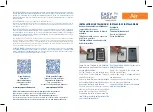
22
fastwaytrailer.com
Using the tongue jack, raise the trailer and back of the tow vehicle together. See
Figure 30. As you raise them, you will see the back ends of the spring bars rise in
relation to the L-brackets. Raise the trailer until the ends of the spring bars are high
enough to be pushed in place over the L-brackets.
If your jack is fully extended before you can get the spring bars over the L-brackets,
use the Snap-up lever to lift the bars in place. Using a block or a jack extension foot,
like the Fastway FLIP™ automatic jack foot, may be helpful to get the spring bars
Step 11 - Hitching Up
Chock the wheels on both sides of the trailer.
Place the e2 head and shank assembly in the receiver hitch, and pin it into place.
Back the tow vehicle up to the trailer, and align the hitch ball directly under the
socket of the trailer coupler. See Figure 28.
Set the parking brake.
Insert the e2 spring bars into the hitch head on both sides. Make sure the retaining
pins lock them into place.
Lower the trailer coupler onto the hitch ball, and latch the coupler so that it’s locked
on the ball. See Figure 29.
Figure 29
Figure 28
when your hitch is new and tightened as explained in Step 9. You will notice that
over time the need to tighten the angle set bolt will diminish, but you should still
check it regularly before each tow as part of your hook-up routine.
Store your hitch out of the weather when not in use. Keep it clean and free from
rust. From time to time, use a good quality rust inhibiting spray paint to touch up
the finish and keep it looking good. Do not paint over the warning stickers. If the
warning stickers become worn or unreadable, contact Fastway Trailer Products for
free replacements.











































